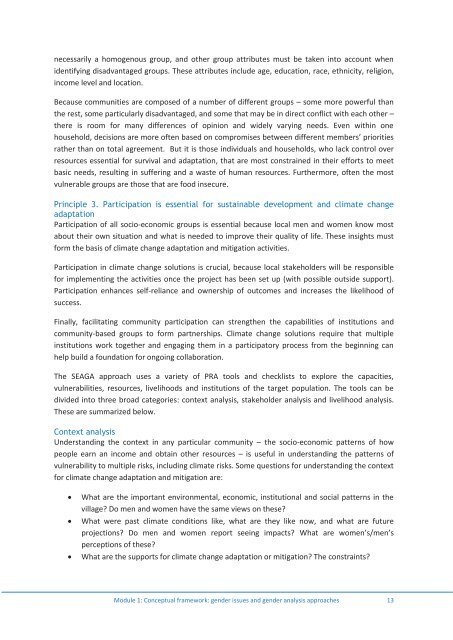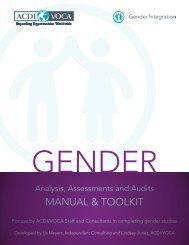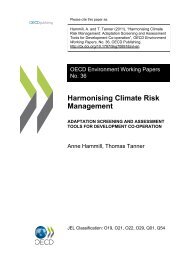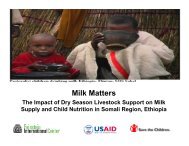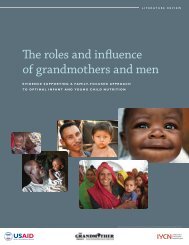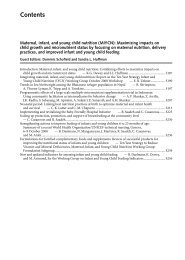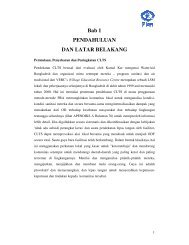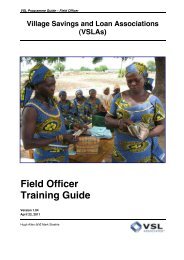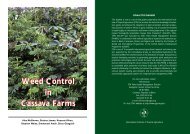Gender and climate change research in - FAO
Gender and climate change research in - FAO
Gender and climate change research in - FAO
You also want an ePaper? Increase the reach of your titles
YUMPU automatically turns print PDFs into web optimized ePapers that Google loves.
necessarily a homogenous group, <strong>and</strong> other group attributes must be taken <strong>in</strong>to account when<br />
identify<strong>in</strong>g disadvantaged groups. These attributes <strong>in</strong>clude age, education, race, ethnicity, religion,<br />
<strong>in</strong>come level <strong>and</strong> location.<br />
Because communities are composed of a number of different groups – some more powerful than<br />
the rest, some particularly disadvantaged, <strong>and</strong> some that may be <strong>in</strong> direct conflict with each other –<br />
there is room for many differences of op<strong>in</strong>ion <strong>and</strong> widely vary<strong>in</strong>g needs. Even with<strong>in</strong> one<br />
household, decisions are more often based on compromises between different members’ priorities<br />
rather than on total agreement. But it is those <strong>in</strong>dividuals <strong>and</strong> households, who lack control over<br />
resources essential for survival <strong>and</strong> adaptation, that are most constra<strong>in</strong>ed <strong>in</strong> their efforts to meet<br />
basic needs, result<strong>in</strong>g <strong>in</strong> suffer<strong>in</strong>g <strong>and</strong> a waste of human resources. Furthermore, often the most<br />
vulnerable groups are those that are food <strong>in</strong>secure.<br />
Pr<strong>in</strong>ciple 3. Participation is essential for susta<strong>in</strong>able development <strong>and</strong> <strong>climate</strong> <strong>change</strong><br />
adaptation<br />
Participation of all socio-economic groups is essential because local men <strong>and</strong> women know most<br />
about their own situation <strong>and</strong> what is needed to improve their quality of life. These <strong>in</strong>sights must<br />
form the basis of <strong>climate</strong> <strong>change</strong> adaptation <strong>and</strong> mitigation activities.<br />
Participation <strong>in</strong> <strong>climate</strong> <strong>change</strong> solutions is crucial, because local stakeholders will be responsible<br />
for implement<strong>in</strong>g the activities once the project has been set up (with possible outside support).<br />
Participation enhances self-reliance <strong>and</strong> ownership of outcomes <strong>and</strong> <strong>in</strong>creases the likelihood of<br />
success.<br />
F<strong>in</strong>ally, facilitat<strong>in</strong>g community participation can strengthen the capabilities of <strong>in</strong>stitutions <strong>and</strong><br />
community-based groups to form partnerships. Climate <strong>change</strong> solutions require that multiple<br />
<strong>in</strong>stitutions work together <strong>and</strong> engag<strong>in</strong>g them <strong>in</strong> a participatory process from the beg<strong>in</strong>n<strong>in</strong>g can<br />
help build a foundation for ongo<strong>in</strong>g collaboration.<br />
The SEAGA approach uses a variety of PRA tools <strong>and</strong> checklists to explore the capacities,<br />
vulnerabilities, resources, livelihoods <strong>and</strong> <strong>in</strong>stitutions of the target population. The tools can be<br />
divided <strong>in</strong>to three broad categories: context analysis, stakeholder analysis <strong>and</strong> livelihood analysis.<br />
These are summarized below.<br />
Context analysis<br />
Underst<strong>and</strong><strong>in</strong>g the context <strong>in</strong> any particular community – the socio-economic patterns of how<br />
people earn an <strong>in</strong>come <strong>and</strong> obta<strong>in</strong> other resources – is useful <strong>in</strong> underst<strong>and</strong><strong>in</strong>g the patterns of<br />
vulnerability to multiple risks, <strong>in</strong>clud<strong>in</strong>g <strong>climate</strong> risks. Some questions for underst<strong>and</strong><strong>in</strong>g the context<br />
for <strong>climate</strong> <strong>change</strong> adaptation <strong>and</strong> mitigation are:<br />
<br />
<br />
<br />
What are the important environmental, economic, <strong>in</strong>stitutional <strong>and</strong> social patterns <strong>in</strong> the<br />
village Do men <strong>and</strong> women have the same views on these<br />
What were past <strong>climate</strong> conditions like, what are they like now, <strong>and</strong> what are future<br />
projections Do men <strong>and</strong> women report see<strong>in</strong>g impacts What are women’s/men’s<br />
perceptions of these<br />
What are the supports for <strong>climate</strong> <strong>change</strong> adaptation or mitigation The constra<strong>in</strong>ts<br />
Module 1: Conceptual framework: gender issues <strong>and</strong> gender analysis approaches 13


